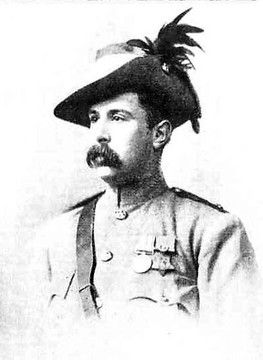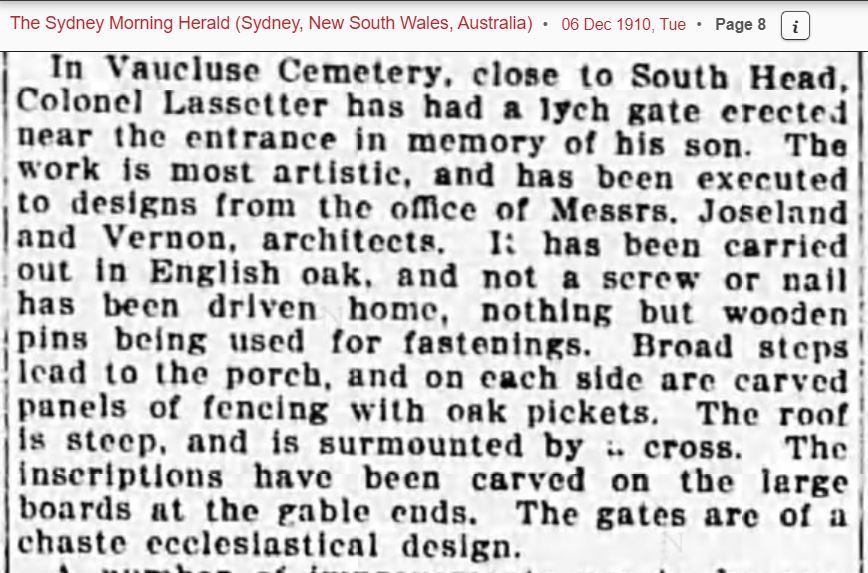GENERAL LASSETTER.
DEATH ANNOUNCED.
Notable Career.
After an illness extending over nearly two weeks, Brigadier-General H. B. Lassetter died at the Lister Hospital at half past five yesterday evening. He was struck down by appendicitis on Saturday week, February 6, and on the following Monday Dr. Sir Alexander McCormack and Dr. Dunlop found it necessary to operate. Since the operation he had seemed to be making favourable progress, but yesterday afternoon took a sudden turn for the worse.
The career of Brigadier-General Harry Beauchamp Lassetter was a distinguished one, both as a soldier and as a man of affairs. He was a native of Sydney. He was born at Darling Point on March 19, 1860, thus being in his 66th year at the time of death. He was the eldest son of the late Mr. Frederick Lassetter, founder of the well-known firm of F. Lassetter and Company, Ltd. For the last 35 years the general had taken a very active part in the conduct of the business, and was chairman of directors. When the war broke out he was preparing for a business trip to Europe. The declaration of war by England hastened his arrangements, and it was generally under-stood that he would join the colours, in view of his brilliant past record. His last command, previous to that time, had been that of the 2nd Australian Light Horse Brigade. He was the founder of the mounted rifles movement in Australia, having come out to New South Wales in 1888 with the express purpose of forming such a corps.
He went to England as soon as he could in January, 1915, and took charge of a brigade of the Territorials ("Terriers"). He was at that time a colonel, and popular with all ranks, for he was a typical soldier, and carried his 55 years remarkably well. It was not long before he rose to be Brigadier-General. In January, 1917, he received the decoration of C.M.G. In 1920 he was demobilised, and came to Australia for a brief visit, but it was not until 1924 that he returned to settle here permanently. The interim he had spent living quietly in London.
General Lassetter was educated at Eton, going from there to Cheltenham, and thence to the Royal Military College at Sandhurst. He entered on his military career in 1880, when he joined her Majesty's 38th Regiment as second lieutenant. He was promoted to a lieutenancy in the 80th Regiment in 1881, and to captain in 1887. He returned to New South Wales in 1888, and after he had raised and trained the Mounted Rifles Regiment here he was promoted to the position of lieutenant-colonel in 1894. In 1897 he went to England with a detachment of Queen Victoria's 60th Jubilee Regiment, and commanded the colonial escort in the Queen's procession. Soon after this he saw active service under Lord Wolseley with the Nile Expedition, crossing the desert to Metemmeh, for which he wore a medal with clasp and a bronze star. It was in the South African campaign in 1902, however, that he distinguished himself most. While in command of the New South Wales Mounted Rifles he was mentioned in despatches, received a medal and clasp, and was also decorated with the order of C.B. Altogether he spent nine years in the Mounted Rifles and 12 in the Imperial service.
The General's family also achieved distinction in the European war. His son, Captain Frederick Macquarie Lassetter, left Cambridge where he was studying law two days after the war broke out, and joined the afterwards famous London Scottish Regiment as a private. He was wounded at the front in 1918, and, being given four months' leave of absence to recuperate, went across to meet his mother in America. Mother and son were returning to England on the Lusitania when the liner was torpedoed by the Germans, and Captain Lassetter had to partially support his mother in the water for several hours before help arrived. By 1918 he had risen to the rank of captain. He obtained first-class honours at the law examinations, and was called to the Bar of the Inner Temple in November, 1919. In the following year the Full Court admitted him to practice at the Bar of New South Wales. He is at present resident in Sydney.
Colonel Lassetter married in 1891 Elizabeth Anne, a daughter of the late Mr. J. M. An-till, father of Lieutenant-Colonel Antill, now Brigade Major (to Colonel Hughes) of the No. 3 A.I. Light Horse Expeditionary Force. She survives him. His brother Frederick went through the South African war as a lieutenant.
The funeral will take place this morning from Christ Church St. Lawrence, where a service will be held at half-past 10. The cortege—a semi-military one—will proceed immediately afterward to the South Head Cemetery. Officers of the Royal Australian Artillery will bear the coffin from hearse to graveside. Those desiring to participate in this action are requested to communicate with the officer in charge of arrangements at the cemetery, who will be there at 11.15. The body will be lowered into the grave of General Lassetter's father, after a graveside service led by the Rev. John Hope (who is to conduct also the service at Christ Church St. Lawrence).
GENERAL LASSETTER.
DEATH ANNOUNCED.
Notable Career.
After an illness extending over nearly two weeks, Brigadier-General H. B. Lassetter died at the Lister Hospital at half past five yesterday evening. He was struck down by appendicitis on Saturday week, February 6, and on the following Monday Dr. Sir Alexander McCormack and Dr. Dunlop found it necessary to operate. Since the operation he had seemed to be making favourable progress, but yesterday afternoon took a sudden turn for the worse.
The career of Brigadier-General Harry Beauchamp Lassetter was a distinguished one, both as a soldier and as a man of affairs. He was a native of Sydney. He was born at Darling Point on March 19, 1860, thus being in his 66th year at the time of death. He was the eldest son of the late Mr. Frederick Lassetter, founder of the well-known firm of F. Lassetter and Company, Ltd. For the last 35 years the general had taken a very active part in the conduct of the business, and was chairman of directors. When the war broke out he was preparing for a business trip to Europe. The declaration of war by England hastened his arrangements, and it was generally under-stood that he would join the colours, in view of his brilliant past record. His last command, previous to that time, had been that of the 2nd Australian Light Horse Brigade. He was the founder of the mounted rifles movement in Australia, having come out to New South Wales in 1888 with the express purpose of forming such a corps.
He went to England as soon as he could in January, 1915, and took charge of a brigade of the Territorials ("Terriers"). He was at that time a colonel, and popular with all ranks, for he was a typical soldier, and carried his 55 years remarkably well. It was not long before he rose to be Brigadier-General. In January, 1917, he received the decoration of C.M.G. In 1920 he was demobilised, and came to Australia for a brief visit, but it was not until 1924 that he returned to settle here permanently. The interim he had spent living quietly in London.
General Lassetter was educated at Eton, going from there to Cheltenham, and thence to the Royal Military College at Sandhurst. He entered on his military career in 1880, when he joined her Majesty's 38th Regiment as second lieutenant. He was promoted to a lieutenancy in the 80th Regiment in 1881, and to captain in 1887. He returned to New South Wales in 1888, and after he had raised and trained the Mounted Rifles Regiment here he was promoted to the position of lieutenant-colonel in 1894. In 1897 he went to England with a detachment of Queen Victoria's 60th Jubilee Regiment, and commanded the colonial escort in the Queen's procession. Soon after this he saw active service under Lord Wolseley with the Nile Expedition, crossing the desert to Metemmeh, for which he wore a medal with clasp and a bronze star. It was in the South African campaign in 1902, however, that he distinguished himself most. While in command of the New South Wales Mounted Rifles he was mentioned in despatches, received a medal and clasp, and was also decorated with the order of C.B. Altogether he spent nine years in the Mounted Rifles and 12 in the Imperial service.
The General's family also achieved distinction in the European war. His son, Captain Frederick Macquarie Lassetter, left Cambridge where he was studying law two days after the war broke out, and joined the afterwards famous London Scottish Regiment as a private. He was wounded at the front in 1918, and, being given four months' leave of absence to recuperate, went across to meet his mother in America. Mother and son were returning to England on the Lusitania when the liner was torpedoed by the Germans, and Captain Lassetter had to partially support his mother in the water for several hours before help arrived. By 1918 he had risen to the rank of captain. He obtained first-class honours at the law examinations, and was called to the Bar of the Inner Temple in November, 1919. In the following year the Full Court admitted him to practice at the Bar of New South Wales. He is at present resident in Sydney.
Colonel Lassetter married in 1891 Elizabeth Anne, a daughter of the late Mr. J. M. An-till, father of Lieutenant-Colonel Antill, now Brigade Major (to Colonel Hughes) of the No. 3 A.I. Light Horse Expeditionary Force. She survives him. His brother Frederick went through the South African war as a lieutenant.
The funeral will take place this morning from Christ Church St. Lawrence, where a service will be held at half-past 10. The cortege—a semi-military one—will proceed immediately afterward to the South Head Cemetery. Officers of the Royal Australian Artillery will bear the coffin from hearse to graveside. Those desiring to participate in this action are requested to communicate with the officer in charge of arrangements at the cemetery, who will be there at 11.15. The body will be lowered into the grave of General Lassetter's father, after a graveside service led by the Rev. John Hope (who is to conduct also the service at Christ Church St. Lawrence).
Family Members
Sponsored by Ancestry
Advertisement
Advertisement











